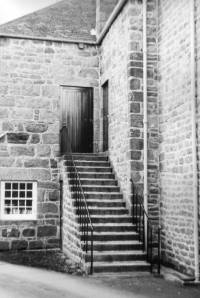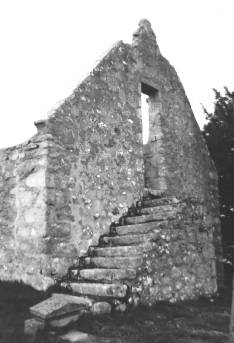|
A Spate of Singing Lofts |
|||
|
David Welch |
|||
|
Reproduced from West Gallery 21, Spring 2002. Text and photos © David Welch, February 2002. |
|||
| The gathering of information about west galleries advocated by Edwin Macadam and Sheila Girling Smith in West Gallery 20 and Jackie Patten in West Gallery 16 is surely welcome. It may give information about when choirs started, and their size and make-up. Also it will show up areas where there was enthusiasm for the music, since the cost of building galleries, and the disturbance to existing seating, would often be major hurdles for the parish and musicians to overcome, and would only happen if the results were considered worthwhile. | |||
|
(Photograph: David Welch) |
For north-east Scotland the revival in psalmody, begun at Monymusk in 1753 and inspired by Sir Archibald Grant, appears to have triggered a spate of building galleries and lofts. A proponent of the psalmody reformation, writing in the Scots Magazine of July 1755, urged “that a body of the singers sit together, generally in some gallery or loft, by which means they mutually assist each other, and lead the voices of such as are scattered in the body of the church, and command them more effectually than it is in the power of any precentor to do”. By August 1755 the same writer reported in the Scots Magazine that “the reformation has already taken place in the following parishes. . . in the order in which they are named, viz. Monymusk, Cluny, Midmar, Kintore, Fintray, Rayne, Old Meldrum, New Aberdeen, Old Aberdeen, Kenethmount, Toway, Dalmoak”, and “there is presently a call for teachers from many more parishes”. He also stated that “gentlemen and ladies usually contribute very generously to ease the poorer people of some of the expense of being taught, and to purchase psalm books for them; and the heritors not only afford their countenance, but have also built commodious lofts or galleries for the performers, in churches where they are wanting”. |
||
|
Some of the lofts must have been small e.g. for Dalmoak (= Drumoak), where the old kirk is both small and narrow. But others were large. Thus in 1754 in Kintore “the new Loft which the Earl of Kintore had built and gave free to those who were taught to sing, contained about 120 people, and had greatly slacken’d the body of the church” (Millar: Four centuries of Scottish Psalmody, p.160). And in Old Aberdeen (now St Machar’s Cathedral) Gideon Duncan had joined “with the thirty or forty people in the College loft who performed their several parts after the new quick method”. In Huntly “the new loft was divided into three parts - one for those who sang the cantus or treble, another for the tenor, and the third for the bassus” (Millar: ibid. p.160 - this loft presumably erected after 1755). |
The external stair at Dalmoak. (Photograph: David Welch) |
||
|
Access to the Kemnay Singers’ Loft was by a grassy slope leading up to a door in the west or front gable, while at Monymusk there is a fine stone external stair (see previous page). This is the only entry into the present West gallery, although the gallery has almost certainly been reconstructed since the eighteenth century, and it possibly had an additional intemal stair at that time. At Dalmoak also, there is an external stair (below) but perhaps this loft and stair pre-dated the psalmody revival. The arrangement whereby choirs sat upstairs probably continued in many Aberdeenshire churches well into the nineteenth century. Anderson in Precentors and Musical Professors (1876) writes about several such churches and recalls the choir of Trinity Church, Aberdeen, occupying the farthest back seats of an end gallery c. 1820-1840 and “the heavy bass voices… rolling down… will not be forgotten”, tunes with bass solo sections often being chosen by the precentor. Moreover, some new Aberdeenshire churches were built with a choir gallery in the late nineteenth and early twentieth centuries, e.g. Cults West kirk. And we still have a cathedral (St Mary’s RC in Aberdeen) in which the musicians operate from a west gallery. |
|||

